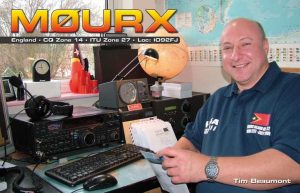If you are new to QSL’ing or just need a reminder or some advice on how best to send your QSL card then this article below will be of interest to you.
A QSL card has been a very important part of Amateur Radio for many years. QSL cards are used for awards and for just the pleasure of collecting the cards. From a QSL managers perspective I have written some guidelines in helping you get 100% QSL return.
Choosing a QSL Card
 The first thing I would say is that a QSL card should be given as much thought as the radio station in your shack.
The first thing I would say is that a QSL card should be given as much thought as the radio station in your shack.
A QSL card for me is more than just a “confirmation of a two way QSO” The QSL can show your culture, shack, antennas, job and so much more with just a little imagination. If you need some help contact a QSL printer and ask for some advice.
Give some thought to the content of the card and the quantity you will be ordering. Usually larger quantities are much less expensive on a per card basis.
Contents of a QSL Card
Your QSL card should always contain the following:
- Your call sign should be on both sides of the QSL, BOLD and be large enough to be read quickly.
Why? A QSL manager for a DXpedition will receive thousands of QSL cards, M0URX can be seen much easier than M0URX hidden on a QSL. Make it easier for the QSL manager to know WHO you are. That is why it should ALWAYS be on the back of the QSL in large letters. - Your name and address, Country Name, website and email address are all usefull information to write on the QSL card.
- QSO report panel should be clear, easy to read. Use UTC (Coordinated Universal Time) time not local time. Frequency or Band, SSB, CW, RTTY etc. RST.
- CQ Zone ITU Zone, Grid Locator, IOTA Reference including Island Name.
Why? Your QSL may be required for a number of awards and this information must be on the QSL card and will be checked by a “field checker”
Sending a QSL to a DXpediton:
- USE OQRS. This is your first option!
- Write the contact details clearly.
- ALWAYS enclose US$ & check QSL Policy. Always first check the DX-pedition website to verify their fee structure.
Why? This pays for the return postage and also helps towards other QSL costs like Bureau expenses, Ink, envelopes, labels. - ALWAYS enclose a Self Addressed return envelope.
Why? Failure to add a Self Addressed return envelope may result in NO REPLY. Writing envelopes by the QSL manager wastes time and adds extra costs to the QSL work.Your Envelope should be written like below. Top left of the envelope write the senders address. If the letter cannot be delivered it will be returned to sender.
If undelivered please return to:
YOUR ADDRESS
AIR MAIL PAR MAIL
Mr Tim Beaumont
83 Limbrick Avenue
Tile Hill Coventry
West Midlands CV4 9EX
ENGLAND – GREAT BRITAIN
Your address should ALWAYS be in the LOWER MIDDLE of the envelope.
Your Country name should ALWAYS be in UPPER CASE letters. It is surprising how many American hams do not write U.S.A. How is the postal worker to know what country to send the letter if you have not written the country of destination?
Write “AIR MAIL PAR AVION” or use a Air Mail sticker, top left, failure to add this could result in the letter going by surface mail and may take up to 12 weeks!
Leave the TOP RIGHT part of the envelope for the Postage Paid Impression
If you send US$ put them inside the return envelope to hide them from possible postal theft.
Put the SAE with the fold to the bottom of the envelope. Why? When the QSL manager opens the envelope the SAE will not be spliced in half.
Seal the envelope in packing tape. Make the letter as tamper proof as possible.
Mail theft is extremely rare these days. Letters are machine sorted and not handled by workers. If a letter does not arrive it has most likely been destroyed by a machine not stolen.
